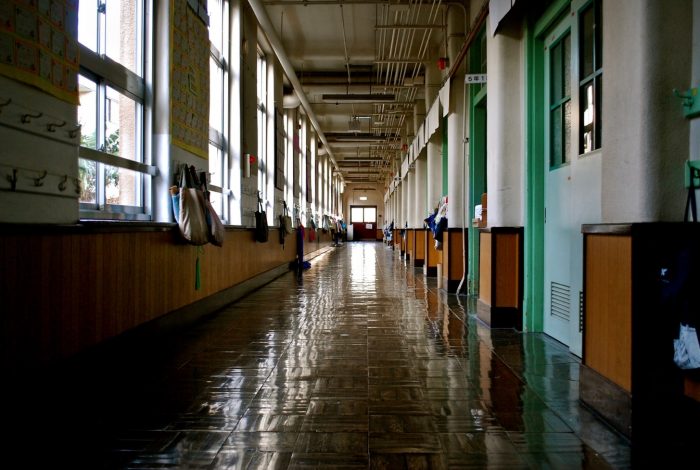Check out Elephant’s Continually-updating Coronavirus Diary. ~ Waylon
~
Waylon’s Crowdcast retreat, How to Show Up for Your Sweet Self, left me feeling filled up to the top with love, peacefulness, encouragement, and purpose.
The idea of service being the ultimate smile—being of benefit for ourselves as well as others—is especially moving right now in the midst of a global pandemic that has millions and millions of people practicing social distancing and relying on others performing essential jobs from medical staff, grocery store workers, police and fire services, postal services, manufacturing, truckers, utility maintenance and repair, and teachers.
There are 3.2 million teachers teaching over 50.8 million public school students, and we are all doing it remotely now.
A fact that was completely unanticipated and for which we were wholly unprepared. Most districts across the country did not have the technology in place—within the schools or students’ and teachers’ homes—to easily pull this off. And yet, we are doing it. We are providing some semblance of structure and curricular based content, while also providing some touchstones of normalcy and social contact for tens of millions of students.
Becoming a public high school English teacher 25 years ago was the best career decision I ever made. I truly love this job, and it is a privilege to play a part in the lives of each one of the more than 3,000 students I have known (so far). Teachers are the backbone of society—we make all other careers and all life choices possible.
We teach children to think, to solve problems, to know where they came from and where they are going. We teach them how to express their thoughts and feelings and that they are worthy, smart, capable, creative, wanted, accepted, appreciated, and loved.
We teach because sharing knowledge and wisdom with our children is the ultimate way of serving others and being of great benefit.
People who are not educators think this is an easy job because they know what it was like for them to be in a classroom as a student, but that is an unfair comparison. Being a teacher is so much more than just planning and delivering a lesson, giving a lecture or a quiz, or assigning a report card grade.
If it were just those things, it still would be challenging. But the real challenge is to make the content interesting, relatable, and applicable to the ever-changing lives of children and teens while meeting state and national standards and the learning needs of 25 to 30 individual students in each of your classrooms.
>> We do all this while making students feel encouraged to be brave and safe and to risk being wrong in order to learn something.
>> We do all this while connecting with them as people and maintaining boundaries and authority.
>> We do all this while nurturing their feelings and validating their struggle.
>> We do all this while also being a therapist, psychologist, confidant, counselor, coach, nurse, friend, disciplinarian, and sounding board.
It’s a monumental and exhausting task and one that makes me thrive. This is a major source of my personal meaning. This is what I was meant to do. This is one of the main ways I am of benefit to others. This service brings me the ultimate smile.
My students and I spend 180 days together each year, and sometimes I have them in class for more than one year. I have had many of their siblings in class and have gotten to know whole families. I become school mom for some, confidants for others, and friends with some once they graduate. Some of my favorite people are former students, and I’m blessed that we can continue to be a part of each other’s lives.
Each day of each year, I am called upon to use all my life skills and hard-won knowledge about life, happiness, finding meaning, navigating family relationships, and encouraging young people to work hard and seek the best in themselves. All the while I am their cheerleader and champion.
An example of this is a young woman, a high school senior, who calls me Mom and runs down the hallway to hug me every single morning, and has opened up to me about not fitting in at home. She doesn’t feel emotionally safe or accepted by her parents and, understandably, this bothers her a great deal. She and I were talking about ideas for her college admissions essay, and she broke down in sobs as what we were talking about touched closely to something painful to her. Instead of telling her to calm down and she would be okay, which would, in effect, tell her that I was uncomfortable with her emotions and tears, I held her and let her cry it out. I showed her I accepted her difficult emotions and was there as her witness and to share it with her.
When people express difficult emotions, it means they feel safe with me, or at least safe enough to risk their vulnerability. It is about them, not about me. I gave her a tissue and a hug, held her for a moment, and told her that she was safe and could cry it out. I was there holding space with her, listening to anything she wanted to say. Sure, she may have been looking for some advice, but more importantly, she was looking for someone to accept her and her difficult emotions, to express what she felt she couldn’t express anywhere else. I gave her that safety and respect and love.
There are more and more of these moments more often than anyone could guess. We live in difficult times of social strife, divisiveness, political clashes, eroding laws and national integrity, economic challenges, very real immigration fears as family unity is threatened by deportation or separation, sickness, death, and injury—and now a global pandemic that separates us from many of our regular touchstones.
Each year, a greater percentage of students come from families touched by divorce, death, illness, military deployment, parental unemployment, immigration, and, oh yeah, the usual adolescent angst about body image, friend groups, and the ever-present struggle between fitting in and genuine belonging.
This job that I have, this calling, this privilege, this honor—I am able to step into the lives of these young people and shape who they might become over the next 10 months or longer, or maybe their whole lives. In their own ways, they shape who I am and who I have become. They’ve touched my life in innumerable ways, and it’s a blessing to my life to have them in mine. Students contact me all the time, years after they were in my class, years after they graduated, to ask me to edit a paper for them, for my advice on how to handle a problem, to share something exciting that just happened in their lives.
When I was going through my divorce over a decade ago, my whole entire life was turned upside down and I was worried about my children, worried about myself, worried about my livelihood, worried about every possible thing that I could control and couldn’t control, I realized how deeply my job of teaching is an absolute blessing. It is an exercise in mindfulness. Being present, one hundred percent, in the present moment.
For the 41 minutes of class, I have to put away all of the things that are bothering me and the problems of the day and focus exclusively on my students, the lesson plan, and their needs. I must focus on how to get from the first minute to the forty-first minute. And in their company, through the camaraderie, jokes, the lesson, and their needs, I am able to lose some of the pain that I was going through and focus exclusively on my job.
Teaching really is one of the most Buddhist professions that there is.
It’s a community of learners. It’s sharing and mindfulness at its best because the only way to do the job is to put everything else aside and focus on the present moment.
There are many days where teaching is a joy, when the students are in a receptive mood, and there is some joking and talking along with lighthearted banter. When it comes time to do the work and focus, everybody is engaged and does their part to make the class great. There is great flow. There is great love. These days remind me why I do this job and why I so eagerly return to it every September. It’s a joy.
Truthfully and obviously, there are also many days when some students aren’t in a receptive mood. For whatever their particular issues that day or that year, they are not able to be fully present and engaged. That is a challenge. I try to light some sort of fire within them, turn them on to the material in some way, or at least get them to play the game of school and get through the day, the week, the semester.
This is where we are now, in a challenging period. Our students are struggling to finish their school year amid confusion, pain, illness, anxiety, and technological complications that prevent them from easily accessing their academic work and their connection with school. And in the case of our current seniors, the graduating class of 2020, the culmination of over 13 years of schooling is being faced from inside their own homes as they wonder if they’ll be able to have the graduation and senior prom they’ve worked hard for and dreamed of for years.
As we practice social distancing trying to flatten the curve of the spread of COVID-19, this virus has claimed “normal” life for us all and unfortunately the lives of many of our loved ones. At the time I’m writing this over 50,000 people have lost their lives to this illness in the United States, and about 200,000 worldwide.
This has all changed and challenged our nation’s teachers and students in ways no one could have predicted, even four months ago.
Students are reaching out to tell me how scared and anxious they are. Some have sick parents, some have parents who are essential workers, and some are essential workers themselves. They are worried about everything and still trying to focus on doing schoolwork in their Google Classrooms.
Recently, an old friend sent me an article about caring teachers who get emotionally burned out and thought I would find it interesting because, as she put it, I’m one of those kinds of teachers. The article made me think about teaching and my students and how much I adore them, care for them, and what a real privilege it is to be a part of their lives.
It’s all so human, real, and visceral. I feel that those are the real reasons I do this job, much more than the literature and the writing instruction. This job is more of a calling and a lifelong commitment to service in many ways.
Please be patient with yourself right now.
Please be patient with your children right now.
Please be patient with your children’s teacher right now.
We are truly doing our best in extraordinary circumstances.
~
Author’s note: Thank you for reading. If you are so inclined, please heart and share! Check out my other articles on Elephant Journal. Pre-order your very own signed copy of my book: Permission to Land.











Read 4 comments and reply